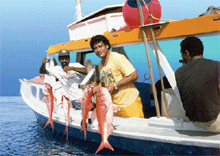The impact of climate change on aquatic ecosystems, fisheries and aquaculture, however, is not as well known. This policy brief, a joint partnership between several agencies, highlights this issue to ensure that decision makers and climate change negotiators consider aquatic ecosystems, fisheries and aquaculture at the UNFCCC COP-15 in Copenhagen, December 2009.
The build-up of carbon dioxide and other greenhouse gases in the atmosphere [1] is changing several of the features of the Earth’s climate, oceans, coasts and freshwater ecosystems that affect fisheries and aquaculture - air and sea surface temperatures, rainfall, sea level, acidity of the ocean, wind patterns, and the intensity of tropical cyclones.

Climate change is modifying the distribution and productivity of marine and freshwater species and is already affecting biological processes and altering food webs. The consequences for sustainability of aquatic ecosystems, fisheries and aquaculture, and the people that depend on them, are uncertain.
Fishers, fish farmers and coastal inhabitants will bear the full force of these impacts through less stable livelihoods, changes in the availability and quality of fish for food, and rising risks to their health, safety and homes. Many fisheries-dependent communities already live a precarious and vulnerable existence because of poverty, lack of social services and essential infrastructure. The fragility of these communities is further undermined by overexploited fishery resources and degraded ecosystems. The implications of climate change for food security and livelihoods in small island states and many developing countries are profound.
Investments are urgently needed to mitigate these growing threats and adapt to their impacts - but also in building our knowledge of complex ocean and aquatic processes. The overarching requirement is to reduce global emissions of greenhouse gasses – the primary human driver of climate change. Fisheries and aquaculture need specific adaptation and mitigation measures that: 1) improve the management of fisheries and aquaculture and the integrity of aquatic ecosystems; 2) respond to the opportunities and threats to food and livelihood security due to climate change impacts, and 3) help the fisheries and aquaculture sector reduce greenhouse gas emissions.
Healthy aquatic ecosystems contribute to food security and livelihoods
Fisheries and aquaculture contribute significantly to food security and livelihoods and depend on healthy aquatic ecosystems - but these facts are often unrecognized and undervalued.
- Fish (including shellfish) provides essential nutrition for 3 billion people and at least 50 per cent of animal protein and minerals to 400 million people from the poorest countries.
- Over 500 million people in developing countries depend, directly or indirectly, on fisheries and aquaculture for their livelihoods.
- Aquaculture is the world’s fastest growing food production system, growing at 7 per cent annually.
- Fish products are among the most widely traded foods, with more than 37 per cent [by volume] of world production traded internationally.
| Crucial Role of Oceans in Climate Change Oceans are the earth’s main buffer to climate change and will likely bear the greatest burden of impacts. Oceans removed about 25 per cent of carbon dioxide emitted by human activities from 2000-2007. Oceans absorb more that 95 per cent of the sun’s radiation, making air temperatures tolerable for life on land. Oceans provide 85 per cent of the water vapour in the atmosphere, these clouds are key to regulating climate on land and sea. Ocean health influences the capacity of oceans to absorb carbon. |
Sustainable aquatic ecosystems - crucial for climate change adaptation
Healthy aquatic ecosystems are critical for production of wild fish, for some of the ‘seed’ and much of the feed for aquaculture. The productivity of coastal fisheries is closely tied to the health of coastal ecosystems, which provide food, habitats and nursery areas for fish. Estuaries, coral reefs, mangroves and sea grass beds are particularly important. In freshwater systems, ecosystem health and productivity is linked to water quality and flow and the health of wetlands.
| Small wild fish like anchovies and sardines found in schools in the ocean are also processed into fishmeal and used to feed other fish (aquaculture) as well as poultry and pigs. These fish are sensitive to changes in ocean conditions. |
Coastal ecosystems that support fisheries also help protect communities from the impacts of natural hazards and disasters [2]. Mangroves create barriers to destructive waves from storms and hold sediments in place within their root systems, reducing coastal erosion. Healthy coral reefs, sea grass beds and wetlands provide similar benefits. Climate change imperils the structure and function of these already stressed ecosystems.
| Coral reefs will degrade with increasing water temperatures and acidification of the oceans [3], and be more sensitive to the threats of over-fishing, pollution, poor tourism practices and invasive species. This will affect the quantity and type of fish available to coastal communities in developing countries and small island states. Ecosystembased approaches to fisheries and coastal management, that recognise the need for people to use coral reefs for their food security and livelihoods, are required to enable these valuable ecosystems to adapt to the effects of climate change, and to reduce the threats from other environmental stressess. |
Fisheries and aquaculture can support mitigation and adaptation
Adaptation measures are well known by managers and decision makers, but political will and action is often lacking. To build resilience to the effects of climate change and derive sustainable benefits, fisheries and aquaculture managers needs to adopt and adhere to best practices such as those described in the FAO Code of Conduct for Responsible Fisheries. These practices need to be integrated more effectively with the management of river basins, watersheds and coastal zones.
By focusing on herbivorous species aquaculture can provide nutritious food with a low carbon footprint. Farming of shellfish, such as oysters and mussels is not only good business, but also helps clean coastal waters, while culturing aquatic plants helps remove wastes from polluted waters. In contrast to the potential declines in agricultural yields in many areas of the world, climate change opens new opportunities for aquaculture as increasing numbers of species are cultured; as the sea encroaches on coastal lands; as more dams and impoundments are constructed in river basins to buffer changing rainfall patterns; and as urban waste demands more innovative disposal.

Fisheries and aquaculture needs to be blended into national climate change adaptation strategies. Without careful planning, aquatic ecosystems, fisheries and aquaculture can potentially suffer as a result of adaptation measures applied by other sectors, such as increased use of dams and hydropower in catchments with high rainfall, construction of artificial coastal defenses or marine wind farms.
Mitigation solutions are not at all well known and require innovative approaches such as the recent inclusion of mangrove conservation as eligible for REDD funding which demonstrates the potential for catchment forest protection under REDD. Other approaches to explore are linking vessel decommissioning with emissions reduction funding schemes, finding innovative but safe ways to sequester carbon in aquatic ecosystems, and developing low-carbon aquaculture production systems.
Many capture fisheries and their supporting ecosystems have been poorly managed and the economic losses due to overfishing, pollution and habitat loss are estimated to exceed $50 billion per year [4]. Improved governance, innovative technologies and more responsible practices can generate increased and sustainable benefits from fisheries. Currently there are more fossil fuel consuming fishing vessels operating than necessary to catch the available fish resources efficiently. Reducing the fleet overcapacity will not only help rebuild fish stocks and sustain global catches, but can substantially reduce carbon emissions from the sector.
Changing the investment climate
Increasing investment in fisheries, aquaculture and aquatic ecosystems is an investment in the ‘liquid assets’ of adaptation. Aquatic ecosystems play a crucial role in buffering and distributing climatic shocks, whether from storms, floods, coastal erosion or drought. Investment in aquatic science is fundamental – investment in knowledge of aquatic ecosystems; in the complex biological and chemical processes that determine the ocean carbon cycle; and in knowledge of the currents and eddies that generate hurricanes. Equally important is an understanding of the ways that people cope with and adapt to living in a changing climate, and how their institutions and livelihood systems have evolved to maintain resilience to future change.
Investment in awareness is also essential – from the local council considering a seawall to policy-makers considering fuel subsidies. Awareness is crucial for the millions who will lose their farms to the sea and need options and alternatives for their own investments and those of their local communities.
Vulnerability and risk assessment can inform these decisions; technologies and education can offer alternatives. Applying best practices in natural resources stewardship and governance is a ‘no regrets’ pathway, generating current and future benefits, increasing resilience of aquatic ecosystems and economies, and often reducing emissions.
|
What Can We Do Now?
|
Implementing the aquatic agenda
Implementing adaptation and mitigation pathways for communities dependent on fisheries, aquaculture and aquatic ecosystems will need increased attention from policy-makers and planners. Sustainable and resilient aquatic ecosystems benefit not only the fishers and coastal communities but also provide goods and services at national and global levels, for example, through improved food security and conservation of biodiversity.
For fishers, fish farmers and coastal peoples in the front line of climate change, for example, low-lying developing countries and small island states, key actions should include securing resources to:
- Fill critical gaps in knowledge to assess the vulnerability of aquatic ecosystems, fisheries and aquaculture to climate change.
- Strengthen human and institutional capacity to identify the risks of climate change to coastal communities and fishing industries, and implement adaptation and mitigation measures.
- Raise awareness that healthy and productive ecosystems, which arise from wellmanaged fisheries and aquaculture, and careful use of catchments and coastal zones, are a cross-sectoral responsibility.
| Fisheries, aquaculture and fish habitats are at risk in the developing world. For example, saltwater intrusion into the Mekong delta from sea level rise and reduced flows threatens the viability of the aquaculture industry for catfish in the delta, which currently produces 1 million tonnes valued at $1 billion a year and provides over 150 000 livelihood opportunities for mostly rural women, unless saltwater tolerant strains can be developed. |
References
[1] IPCC (2007). Intergovernmental Panel on Climate Change. Available from http://www.ipcc.ch/ ipccreports/assessments-reports.htm
[2] ProAct Network (2008) The Role of Environmental Management and Eco-Engineering in Disaster Risk Reduction and Climate Change Adaptation.
[3] Hoegh-Guldberg, et al. (2007) Coral reefs under rapid climate change and ocean acidification. Science 318: 1737-1742.
[4] World Bank and Food and Agriculture Organization, 2008 The Sunken Billions. The Economic Justification for Fisheries Reform. Agriculture and Rural Development Department. The World Bank. Washington DC.
June 2009



